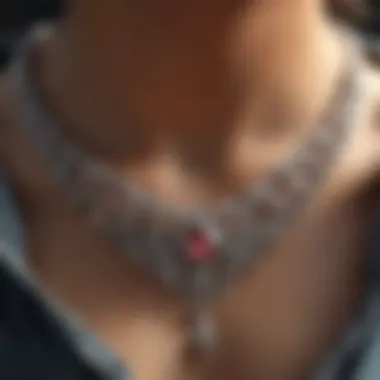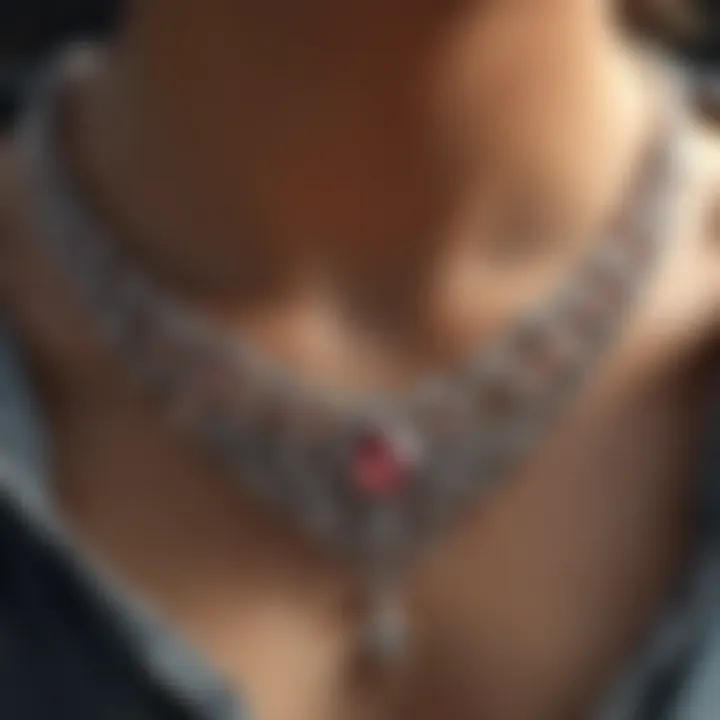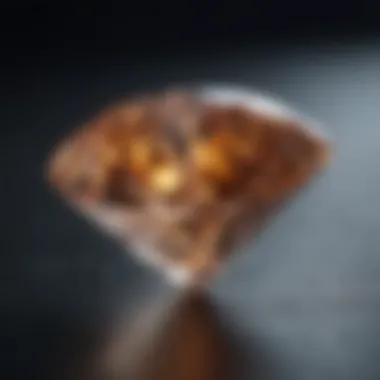Where to Sell My Diamond: A Comprehensive Guide


Intro
Selling a diamond can be a complex process, one that requires not just knowledge of the market but also an understanding of its intricacies. This guide aims to simplify that journey for both novices and seasoned sellers. By exploring different channels, from private sales to auction houses, and online marketplaces, the goal is to empower sellers with the necessary insights to maximize their returns.
The diamond market is influenced by several factors, including trending buyer preferences, economic conditions, and the unique value of each diamond. Understanding these elements can significantly impact the selling experience and success. This guide will gently step through each aspect, ensuring clarity without overwhelming complexity.
Gemstone Overview
Definition and Characteristics
Diamonds are not just beautiful stones; they hold unique properties that define their value. A diamond is a form of carbon arranged in a crystal structure, which gives it unparalleled hardness and brilliance. The value of a diamond is assessed through the 4Cs: Carat, Cut, Color, and Clarity. These factors work together to determine the diamond's overall quality and desirability.
Carat refers to the weight of the diamond. While larger diamonds are typically more valuable, the other characteristics play a critical role. Cut describes how well the diamond has been shaped and polished, affecting its sparkle. Color ranges from colorless to hues, with colorless diamonds usually fetching higher prices. Lastly, clarity addresses the presence of internal or external blemishes, impacting visual appeal.
Classification of Gemstones
Diamonds fall under the broader category of gemstones, which can be classified in various ways. They are often categorized based on the material, color, and value. Besides diamonds, there are precious stones like emeralds, rubies, and sapphires, which generally hold more monetary value than semi-precious stones such as amethyst or garnet.
- Precious Gemstones: Diamonds, Rubies, Sapphires, Emeralds
- Semi-Precious Gemstones: Amethyst, Citrine, Turquoise
This classification helps buyers understand the market better, which is crucial when selling a diamond. By knowing where a diamond fits within this spectrum, sellers can set realistic expectations for their sale.
"Understanding the characteristics and classification of gemstones is fundamental for effective selling."
Historical Significance
Ancient Uses and Cultural Importance
Throughout history, diamonds have been imbued with significance that transcends mere aesthetics. In ancient cultures, diamonds were believed to possess mystical properties, offering protection and strength to their wearers. In India, for instance, diamonds were used in ceremonial weapons and were considered symbols of wealth and status.
Myths and Legends Surrounding Gemstones
Many myths surround diamonds, adding to their allure. Some cultures believed that diamonds could bring good luck, while others thought they had healing properties. Such beliefs often influence buyer behavior and perceptions of value today. Understanding these myths can enhance the narrative a seller shares with potential buyers, adding depth to the selling process.
Understanding Diamond Value
Understanding the value of diamonds is fundamental for anyone looking to sell these precious gems. It directly impacts the selling strategy and negotiation power. While many sellers may hold sentimental value to their diamonds, potential buyers tend to focus heavily on market valuation. A clear grasp of what influences a diamond's worth ensures informed decisions and enhances the selling process.
Key Factors Influencing Diamond Value
Each diamond is unique, and its value is influenced by multiple factors. Sellers must understand these attributes, as they dictate how much buyers are willing to pay.
Carat Weight
Carat weight signifies the size of the diamond. Generally, the higher the carat weight, the more valuable the diamond. Larger diamonds are rare, making them a desirable choice for investors. However, the value does not increase linearly with size. A diamond weighing two carats may not be worth double that of a one-carat diamond. Therefore, assessing carat weight in conjunction with other factors is important.
Cut Quality
The cut of a diamond affects its brilliance and overall appearance. A well-cut diamond will reflect light beautifully, making it more attractive to buyers. Cut grades range from excellent to poor, influencing how light interacts with the stone. The uniqueness of this characteristic is that it can enhance or diminish the beauty of the stone, regardless of its other attributes. Thus, understanding cut quality is essential for maximizing sale potential.
Color Grade
Color grading refers to the absence of color in a diamond, which influences its value. Diamonds are graded on a scale from D (colorless) to Z (light yellow). The most coveted diamonds are those that are completely colorless. A diamond with a higher color grade will generally command a higher price. Sellers should consider this aspect when determining the optimal time and place to sell.
Clarity Assessment
Clarity describes the presence of internal or external blemishes. Diamonds that are graded as flawless or internally flawless are rarer, thus more valuable. A clarity assessment helps determine how clean a diamond appears to the naked eye. Understanding clarity can change the perspective on how much to expect from a sale. Sellers should ensure that their diamonds are properly evaluated for clarity to provide buyers with accurate information.
Market Demand and Trends
Keeping an eye on market demand and trends is equally important for diamond sellers. Various external factors play a role in how diamonds are valued in the marketplace. Sellers can adjust their strategies based on this changing landscape.
Economic Factors
The overall health of the economy influences the diamond market. Economic stability often leads to increased consumer spending on luxury items like diamonds. Understanding economic trends helps sellers time their sales to maximize profit. Economic downturns may drive prices down, affecting potential sales.
Consumer Preferences
Shifts in consumer preferences also dictate diamond sales. For instance, there is a growing interest in ethical sourcing, leading many buyers to prefer lab-grown diamonds. Sellers must stay informed about these changes to better attract potential buyers. Knowing current consumer preferences can guide the selling strategy and improve the odds of a successful transaction.
Emerging Markets


Emerging markets present new opportunities for diamond sales. Regions such as Asia and Africa are witnessing an increase in diamond demand due to rising middle classes. Sellers may find better pricing and more buyers in these markets. However, understanding the cultural significance of diamonds in different regions is crucial for creating the right approach to selling.
Preparing to Sell Your Diamond
Preparing to sell your diamond is a crucial initial step that directly influences the outcome of the sale. Understanding how to get ready for the sale helps you present your diamond in the best light, enhancing its value and appeal to potential buyers. Knowledge about planning can ensure that you gather the necessary documentation, undertake effective cleaning, and present your diamond attractively.
Thorough preparation reduces the chances of complications or delays that could arise during the selling process. It allows sellers to approach the market with confidence, knowing they have all the right information and presentation techniques. Given that diamonds have a significant monetary value, careful preparation can lead to achieving higher returns.
Gathering Documentation
Gathering proper documentation is essential when selling a diamond. It serves as proof of the diamond's authenticity and qualities, which can greatly affect its marketability and price. To facilitate a successful sale, several documents are critical.
Gemological Institute Reports
Gemological Institute Reports are evaluations conducted by recognized laboratories, like the Gemological Institute of America (GIA). These reports provide a detailed analysis of a diamond's characteristics, such as carat weight, cut, color, and clarity. This transparent verification helps establish trust between buyer and seller, making it easier to negotiate price.
The key characteristic of these reports is their comprehensive nature. They detail everything about the diamond in a structured format, ensuring there are no surprises for the buyer. For those looking to maximize their diamond’s value, a GIA report is often viewed as essential, as it can justify a higher asking price.
However, obtaining a report may involve time and costs. Sellers should weigh these factors against the potential benefits.
Sales Receipts
Sales receipts provide a transaction record of the diamond’s original purchase. This documentation is useful as it may show the initial investment and the diamond's original attributes. Having this paper trail can help buyers feel more secure in their purchase, knowing they are dealing with a legitimate seller.
The key characteristic of sales receipts is that they provide historical context to the diamond. They bolster your credential as a responsible seller. While receipts enhance trust, they may not always reflect the current market value accurately, especially in a fluctuating market.
Insurance Appraisals
Insurance appraisals are third-party evaluations that assess the diamond's worth for insurance purposes. These appraisals can also serve as valuable documentation when selling. They show potential buyers that the diamond has been evaluated independently, adding another layer of credibility.
The uniqueness of insurance appraisals lies in their professional assessment. They may highlight aspects that enhance value, such as rarity or specific quality issues. However, the primary focus of these appraisals is different from resale values and may not align perfectly with current market conditions.
Cleaning and Presenting the Diamond
The appearance of the diamond can significantly influence buyer interest. Proper cleaning and presenting techniques enhance the sparkle and luster of the gem, making it more attractive during the sales process.
Professional Cleaning Services
Engaging professional cleaning services can be an effective way to ensure your diamond shines at its best. Qualified jewelers or cleaning specialists employ techniques that are safe and thorough, restoring the diamond's unique beauty without risk of damage.
The key characteristic of professional cleaning is the expertise involved. These professionals often have tools and products that are not available to regular consumers. Although these services usually come with a cost, they often result in a noticeable improvement in appearance, increasing the likelihood of a successful sale.
Effective Display Techniques
How you present the diamond can strongly impact a buyer's impression. Effective display techniques can include using proper lighting, appropriate settings, and showcasing its unique qualities. The way the diamond is marketed, through photos or in-person displays, can affect buyer perception.
The uniqueness of effective display techniques lies in their ability to create an emotional connection. Interesting displays draw attention, leading to potential buyers being more willing to consider a purchase. However, not all display techniques will resonate equally with all audiences, making it important to tailor approaches according to the target market.
"Effective preparation and presentation are vital in achieving a desirable end result when selling a diamond."
In summary, preparing to sell your diamond is an integral part of the process. Gathering the right documentation alongside making the diamond visually appealing can make a marked difference in the selling experience.
Where to Sell Your Diamond
Determining where to sell your diamond is a crucial decision that can significantly influence the overall outcome of the sale. Various options are available, each with its unique characteristics, benefits, and drawbacks. Understanding these options helps sellers make informed choices. This section will examine some primary avenues for selling diamonds, including jewelry stores, auction houses, online marketplaces, and private sales. This understanding aids in maximizing returns and ensuring the seller's needs are met effectively.
Jewelry Stores
Pros of Selling to Local Jewelers
Selling to local jewelers can be a beneficial choice for many diamond sellers. One major advantage is the convenience of a quick sale. Local jewelers often have a direct interest in purchasing diamonds for resale. This can mean that the transaction happens swiftly without complicated processes.
Moreover, local jewelers usually have established reputations within the community, which adds a layer of trust. Sellers can receive immediate payment once the price is agreed upon. Sellers should, however, be aware that the offers made by local jewelers may be lower than what one could expect in an auction or private sale.
Cons of Retail Sales
Despite the advantages, there are drawbacks to selling to retail jewelry stores. One primary concern is the potential for lower prices than other options. Local jewelers often need to make a profit, which can limit the amount they’re willing to pay for the diamond.
Additionally, selling through these stores may limit the seller's options for negotiation. The price offered might be non-negotiable. Jewelers can also be selective about the type of diamonds they purchase, focusing on specific cuts or qualities that may not align with what one wishes to sell.
Auction Houses
Renowned Auction Platforms


Auction houses can offer a high-profile platform for selling diamonds. They attract a global audience, increasing the chance of finding buyers willing to pay higher prices. Renowned auction platforms such as Sotheby's and Christie's have a strong track record of successful diamond sales.
One of the significant aspects of auction houses is the competitiveness of the bidding process, which can drive up prices beyond expectations. However, sellers should note that not all diamonds reach their reserve price, which could result in an unsold item.
Understanding Auction Fees
Engaging with an auction house comes with fees that can impact the final sale proceeds. Understanding these fees is essential before proceeding. Auction fees often include a seller’s commission, which can range from 5% to 25%. There may also be additional costs for marketing or preparation of the diamond, depending on the house.
These fees can reduce the overall sale return, and sellers must weigh these costs against potential high bids from buyers during the auction. It’s crucial to do thorough research on the fee structure before committing to an auction house, allowing for a clearer financial outlook.
Online Marketplaces
Evaluating Trusted Websites
In today's digital era, online marketplaces have become popular platforms for selling diamonds. Websites like eBay and Etsy can connect sellers with buyers worldwide. One significant aspect of these platforms is the extensive reach. Sellers can attract various potential buyers, some willing to pay a premium.
However, it’s paramount to evaluate the credibility and trustworthiness of these websites before listing the diamond. Researching seller reviews and examining the site's policies can help in choosing a reliable platform. This due diligence can lead to a smoother transaction and reduce the risk of scams.
Creating Effective Listings
Creating an effective listing is essential for online sales. This involves writing clear and detailed descriptions of the diamond, including its carat weight, cut, color, and clarity. Quality photographs also play a vital role in presentation. Sellers should consider investing in professional photography to showcase the diamond's features accurately.
The uniqueness of the listing can attract more potential buyers. Furthermore, adequately setting the price based on comparable sales can make a significant difference in receiving fair offers. Crafting a compelling listing is beneficial for standing out in a crowded online marketplace.
Private Sales
Reaching Out to Networks
Engaging in private sales allows for a more personalized transaction. Networking through friends, family, and acquaintances can lead to potential buyers that are already trusted. This method often results in fewer complications compared to formal sales environments. Sellers can negotiate directly with interested parties, allowing for flexibility in pricing.
However, the challenge can be finding an interested party who is willing to meet the seller's expectations regarding price. It may take longer compared to other methods, but the potential for a more favorable deal exists.
Negotiating Directly with Buyers
Direct negotiations with buyers can be advantageous for several reasons. Sellers maintain full control over the selling process, allowing them to adjust their strategy based on the buyer's responses. This direct engagement can lead to a more satisfying sale outcome for both parties.
Nevertheless, negotiating requires good communication skills and market knowledge. Buyers may attempt to lower the price, and being well-prepared is essential to navigate this aspect effectively. Here, creating a firm bottom line and being ready to articulate the diamond's value can help secure a better deal.
Legal Considerations When Selling Diamonds
Selling a diamond involves not only understanding its value but also navigating the legal landscape that can affect the selling process. Legal considerations are crucial for establishing ownership, ensuring the legitimacy of the transaction, and understanding any tax implications that may arise. Being aware of these factors helps sellers avoid potential legal issues and maximize their return on investment.
Ownership Verification
Proving Provenance
Proving provenance is a key aspect of ownership verification. It involves documenting the origin of the diamond, providing a clear chain of custody from the mine to its current owner. This process is essential as it protects the seller from future claims on ownership and increases buyer confidence. A well-documented provenance can greatly enhance the diamond's value, making it an attractive choice for buyers, as it reassures them about the diamond's legitimacy.
One unique feature of proving provenance is the acclaimed Gemological Institute of America (GIA) grading report. This report details various characteristics of the diamond, serving as an unbiased reference that validates its description. While this documentation can be helpful, its absence may deter potential buyers, leaving the seller at a disadvantage. Thus, ensuring a trackable provenance is a significant aspect of selling diamonds successfully.
Handling Inherited Diamonds
Handling inherited diamonds introduces its own set of complexities. Inheritance often involves emotions as much as legalities. Establishing rightful ownership of inherited diamonds is vital for any future sale. The key characteristic here is the necessity of clear documentation, such as wills or estate papers, that substantiates the claim of ownership. This process may not only provide peace of mind to the seller but also add to the diamond's market appeal.
However, one should consider the emotional attachment to inherited pieces, which can complicate the decision to sell. Balancing sentiment with practicality is essential. Moreover, the diamond may have historical value, which might not be immediately evident in its market price. Therefore, it can prove beneficial to have an appraisal before making a sale decision.
Tax Implications
Capital Gains Tax Overview
Understanding capital gains tax is crucial for anyone selling diamond assets. Capital gains tax applies to any profit made from the sale of the diamond, calculated based on the purchase price and the selling price. This tax is assessed at both federal and, potentially, state levels; thus, knowledge about it offers insight into the exact amount the seller will gain after the sale.
A notable aspect is that the taxation rates may vary depending on whether the asset is deemed short-term or long-term; assets held for longer than a year typically enjoy lower rates. This feature emphasizes the importance of keeping accurate records of the acquisition price to improve tax outcomes when selling the diamond.
Deductions and Reporting
Deductions and reporting are crucial when it comes to tax matters related to diamond sales. Sellers are often able to deduct expenses incurred during the sale, like appraisal fees or auction house commissions, which can play a significant role in minimizing taxable gains. Proper documentation of these expenses is needed to ensure that they are considered in tax filings.
Another important point is reporting any profits earned from the sale on tax returns. Failing to do so can lead to penalties and added interest. Therefore, being proactive with tax reporting and understanding potential deductions enables sellers to manage their finances efficiently.
Always consult a tax professional when dealing with valuable assets like diamonds. They can offer tailored advice based on individual circumstances.


Tips for Maximizing Sale Value
Maximizing the sale value of a diamond transcends mere valuation. It is about positioning the jewel effectively in a market filled with diversely informed buyers. The approach you take in marketing your diamond impacts its perceived value, ultimately enhancing the financial return you can secure. Successful strategies not only require a solid understanding of the diamond itself but also an awareness of buyer psychology and market dynamics.
Effective Marketing Strategies
Highlighting Unique Features
Unique features of a diamond can dramatically influence its appeal. Showcasing characteristics such as the quality of the cut, color intensity, and clarity level can captivate potential buyers. For instance, a diamond with a rare color can attract attention, making it stand out in a crowded marketplace. This strategy is beneficial because it emphasizes aspects of the diamond that may justify a higher price.
Key characteristics often include color saturation or an unusual shape, which set it apart from more common choices. By articulating such features well, you not only inform the buyer but also enhance the perceived value. However, it is critical to avoid overstating attributes; transparency builds trust.
Utilizing Social Media
Social media platforms serve as a modern marketplace, where diamonds can gain visibility quickly. Channels such as Instagram and Facebook have become crucial in reaching potential sellers. These platforms allow you to share images and stories that engage a wider audience, creating connections that may lead to sales.
A significant aspect of social media is its immediacy. By showcasing your diamond through high-quality images or videos, you target a diverse audience. While this approach can yield significant advantages, such as global reach, it also has challenges. You must navigate perceptions and ensure that your presence remains professional.
Understanding Buyer Psychology
Grasping buyer psychology can enhance a seller's strategy. Understanding what motivates potential buyers is critical to tailor your approach effectively. Various psychological triggers can influence decisions in the buying process.
Positioning the Diamond
Positioning is an essential factor in understanding buyer psychology. Properly framing the diamond within a narrative can elevate its status, making it more appealing to prospective buyers. For instance, highlighting its journey of acquisition or the emotions associated with it can add sentimental value, enhancing the overall worth.
The primary characteristic of effective positioning is context. When buyers perceive value beyond the physical characteristics, they are often willing to pay more. On the other hand, failing to present your diamond with an engaging narrative can lead to missed opportunities in maximizing sale value.
Creating Urgency in Sales
Creating urgency can significantly impact a buyer's decision-making process. When buyers feel that they might lose an opportunity, they are more likely to act quickly. This strategy can take various forms, such as limited-time offers or highlighting the exclusivity of the diamond.
An important feature is the emotional aspect of urgency. By inducing a sense of scarcity or time sensitivity, you compel buyers towards immediate action. However, one should be careful to balance between genuine urgency and pressure tactics. Overdoing urgency can alienate potential buyers or erode trust.
"Maximizing the sale value of a diamond involves understanding the complex interplay of unique features, buyer psychology, and effective marketing strategies."
Post-Sale Considerations
Post-sale considerations play a crucial role in ensuring that the diamond selling experience does not end at the transaction. Thinking about what happens after the sale can significantly impact the seller's financial future and emotional satisfaction. This section dives into what to evaluate post-sale, ensuring that each aspect contributes positively to the overall goal of maximizing the value received from the diamond.
Evaluating the Selling Process
A thorough evaluation after selling helps understand the strengths and weaknesses of the entire process. This assessment can provide insights useful for future transactions and reinforce strategies that worked well.
Recording the Transaction
Recording the transaction involves documenting all details related to the sale. Essential aspects like the sale date, buyer’s information, and sale price must be noted. This meticulous record-keeping contributes to transparency and can aid in future tax calculations or when proving ownership.
The key characteristic of recording the transaction is its ability to create a paper trail. This is crucial for legal purposes and personal tracking. In this article, it is promoted as a beneficial choice because it solidifies the legitimacy of the transaction. Not_only does it provide evidence of the sale, but it also helps in maintaining accountability.
However, one unique feature of this aspect is the increased security it offers. By having documented details, sellers can more easily resolve any issues that may arise after the sale. While it may seem a simple step, neglecting this could lead to complications later on, such as disputes over the sale terms or potential tax liabilities.
Handling Unforeseen Issues
Handling unforeseen issues is about preparing for potential complications that may arise after the diamond is sold. This aspect includes dealing with buyer disputes, returns, or any unexpected legal matters. Addressing these situations is vital for safeguarding the seller's interests.
The key characteristic of this approach is its proactive nature. Being ready for issues means that sellers can shield themselves from possible financial loss or legal troubles. This is why it is emphasized as a beneficial choice in this article. It allows sellers to manage challenges efficiently without losing time and resources.
A unique feature of this consideration is the importance of communication. Effective handling of issues often relies on the ability to communicate promptly and clearly with the buyer or any involved parties. Though challenging, good communication can mitigate most potential disputes and provide clarity in tricky situations.
Reinvesting or Utilizing Proceeds
Once a diamond is sold, the next step is what to do with the proceeds. The decisions made in this stage can have long-lasting effects on financial health. It's important to choose wisely how to reinvest or utilize the funds.
Investment Options
Investment options refer to various avenues where the proceeds can be allocated to potentially generate returns. These options can range from low-risk savings accounts to high-risk stocks or even alternative investments like real estate. Evaluating what fits best with individual financial goals is essential.
The key characteristic of investment options is the variety available. This diversity allows for tailored approaches that align with personal risk tolerance and desired returns. In this article, investment options are highlighted as a beneficial choice since they enable sellers to grow their funds instead of letting them sit idly.
One unique feature of this aspect is the potential for compound growth. By investing wisely, the initial amount from the diamond sale can become significantly larger over time. However, it's crucial to understand each option's advantages and disadvantages. Not every investment is suitable for every individual, and knowing when to take risks and when to play safe is vital.
Practical Uses for Cash
Practical uses for cash focus on how the obtained money can be spent or allocated for immediate needs. This could range from paying off debts to financing a major purchase or even funding a lifestyle change. It's important to consider how best to utilize those funds for personal benefit.
The key characteristic of this approach is the immediacy it offers. Unlike investing, which may take time to yield returns, practical uses provide instant gratification. This makes it appealing for sellers needing urgent financial resolutions, which is why it is included prominently in this article.
A unique feature of practical uses is their flexibility. These funds can be directed toward anything from emergencies to planned expenses without the need for waiting periods associated with investment gains. However, one must be cautious. Spending cash without a plan can lead to poor financial decisions later on. Finding a balance between enjoying the proceeds and safeguarding future finances is essential.







